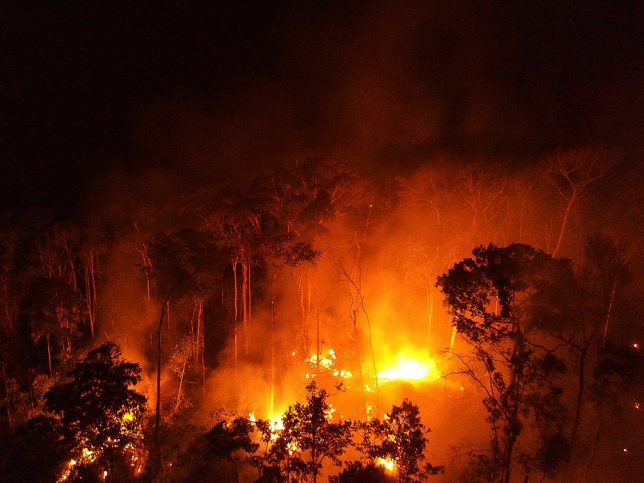
This absurd increase shows the lack of policies to combat deforestation and environmental crimes in the Amazon, driven by the current administration. … The destruction just isn’t stopping.
—Romulo Batista, Greenpeace Brazil
By Jenna McGuire, Common Dreams (CC BY-NC-ND 3.0).
Deforestation in the Brazilian Amazon reached a record high for the month of February, jumping by nearly two-thirds over last February’s level, according to official data released Friday.
Satellite images released by the Brazilian space agency INPE’s DETER monitoring program show 199 square kilometers (77 square miles) of the Amazon rainforest was lost to deforestation last month—the highest rate recorded in February since the agency began keeping records in 2015 and a 62% increase from last year during the same month.
Environmentalists find the data particularly alarming since February is considered the rainy season in the Amazon and generally sees the lowest rates of deforestation throughout the year.
As Indigenous communities and global environmentalists have been sounding the alarm on the imperiled rainforest, deforestation has skyrocketed under Brazil’s right-wing President Jair Bolsonaro. While the Amazon covers land in nine countries, approximately 60% of the forest lies in Brazil, which has reached its highest level of deforestation in more than a decade.
“This absurd increase shows the lack of policies to combat deforestation and environmental crimes in the Amazon, driven by the current administration. The destruction just isn’t stopping,” said Romulo Batista of Greenpeace Brazil in a statement.
Since Bolsonaro took office, deforestation in the Amazon has skyrocketed. A new set of bills proposed in the Brazilian Congress would enable further destruction that the forest cannot afford. We must fight for the Amazon, Indigenous Peoples rights, and for the climate. pic.twitter.com/IjuUg1VaHQ
— Greenpeace (@Greenpeace) March 11, 2022
Deforestation is predominantly caused by animal agriculture, soy production, logging, mining, and major construction, and has greatly impacted the nearly one million Indigenous people from over 300 tribes who live in the Brazilian Amazon.
“We are going to be eating the rainforest in our burgers,” Holly Gibbs, a land use scientist at the University of Wisconsin at Madison, told the Washington Post. “This is our moment as Americans to step forward and leverage some pressure to save the world, by helping to save the Amazon, which is critically important for the future of our planet.”
Research published this week in the journal Nature Climate Change found that the world’s largest rainforest was quickly reaching its “tipping point” and that the Amazon “has been losing resilience since the early 2000s, risking dieback with profound implications for biodiversity, carbon storage, and climate change at a global scale.”
